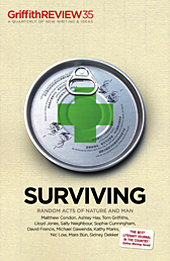Featured in

Buy
$27.99
- Published 20120306
- ISBN: 9781921922008
- Extent: 264 pp
- Paperback (234 x 153mm), eBook

Already a subscriber? Sign in here
If you are an educator or student wishing to access content for study purposes please contact us at griffithreview@griffith.edu.au
Share article
More from author

Between different worlds
IntroductionAntarctica offers windows into many different worlds...
More from this edition

Interview with
Tom Bamforth
InterviewHow long had you been working in Pakistan before the 2005 earthquake struck?Six months. I was there beforehand, during and after, so I saw...

Fire words
GR OnlineTo understand why our language about fire is so poor, it is interesting to look at a history of how this language developed.

The day the earth shook
GR OnlineBEING IN THE middle of the Christchurch earthquake was the most frightening experience of my life. It was a category 6.3 on the Richter...
Stay up to date with the latest, news, articles and special offers from Griffith Review.